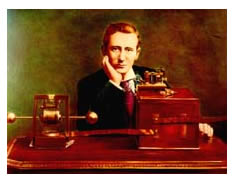 |
 All Classic Ads Vintage Collection - Marconi related ads All Classic Ads Vintage Collection - Marconi related ads
Ad • Ad

|
|
History of Marconi (1896)
 Guglielmo Marconi (1874-1937) was born in Bologna, Italy and has been called the 'father of radio'. In the early 1890s, Marconi began reading papers on the topic of 'Hertzian waves', including those by, amongst others, James Clerk Maxwell, Heinrich Hertz, Nikola Tesla and Sir Oliver Lodge. Guglielmo Marconi (1874-1937) was born in Bologna, Italy and has been called the 'father of radio'. In the early 1890s, Marconi began reading papers on the topic of 'Hertzian waves', including those by, amongst others, James Clerk Maxwell, Heinrich Hertz, Nikola Tesla and Sir Oliver Lodge.
These individuals had performed important research on electromagnetism, and had indeed quantified the underlying theories; they had also introduced a number of important experiments that demonstrated the principles involved.
However, it can be said that Marconi was the first individual to both consider and realise the practical and commercial application of this technology; he took 'wireless telegraphy' out of the physics laboratory and into the industrial world.
In 1894 Marconi began performing experiments with wireless telegraphy, mentored by Professor Augutus Righi, a close family friend, expert on 'Hertzian waves' and professor at the University of Bologna.
Marconi used so-called 'Righi oscillators (improved multiple oscillators) in his early wireless telegraphy experiments. Marconi soon succeeded in signalling up to a distance of 1.5 miles using basic and crude apparatus.
Marconi immediately appreciated the military potential of such a signalling system and offered the technology to the Italian government who refused.
The early history of the Marconi Company 1896-1914
The history of the commercial development of wireless telegraphy has its origins in England: in March 1896, Guglielmo Marconi lodged the first wireless telegraphy patent: a 'holding patent' for a wireless telegraphy system in London. On 2 June 1896, Marconi lodged a full specification for the world's first practical wireless telegraphy system and by the end of the year had extended the range of communications to nine miles. In July of 1897, Marconi was granted his famous British patent (No. 12039) and founded the Wireless Telegraphy and Signal Company Ltd. in London, with the intention of acquiring Marconi patents on an international scale. In December 1897, Marconi established the first wireless station, at the Royal Needles Hotel on the Isle of Wight. It has been said that "from 1897 until the cataclysm of World War One, Wireless Telegraphy was woven into the social and economic fabric of the most sophisticated societies with astonishing speed."
In December 1898, the Marconi Company opened the world's first wireless factory at Chelmsford, Essex. On 27 March 1899, Marconi transmitted across the English Channel from Wimereux near Boulogne, France to South Foreland Lighthouse near Dover, England. Also in 1899, wireless telegraphy was adopted by the British Royal and Merchant Navies. On 12 December 1901, a wireless signal consisting of the Morse code for the letter 'S' was successfully transmitted across the Atlantic from Poldhu, Cornwall to Signal Hill, St John's, Newfoundland, Canada. This transmission over a distance of nearly 2,000 miles was a major achievement as even Marconi himself was unsure of the maximum range of this new technology. By the end of 1902, Marconi had established permanent and reliable wireless stations at Glace Bay in Nova Scotia, Canada and Cape Cod, US. By 1903, the Company had built a number of stations on shore and many merchant ships had been fitted with its wireless sets, which had to be rented from the company and were operated by Marconi personnel, who were allowed to communicate with operators using apparatus from rival companies during emergencies only. As a result of the growing maritime business the Marconi Company began to make a profit.
By 1904, wireless telegraphy had succeeded in being widely recognised as an essential means of modern communication and was used by both side in the Russo-Japanese War of that year. In January 1909, wireless telegraphy saved over 4,000 lives when it was used to call for rescue when the SS Republic collided with the SS Florida off the shores of Nantucket; this provided the Marconi Company, and indeed wireless telegraphy itself, with the respectability and public acclaim it had been clamouring for. Later in the year, Marconi was co-awarded the Nobel Prize for Physics; the prize was shared with Prof. Karl Ferdinand Braun, a fellow pioneer in the field of wireless telegraphy.
In March 1910, the Marconi Company put forward a plan to link the many far-flung parts of the British Empire by a world-wide chain of 18 high power wireless stations including shore-based and ship-based stations, charging half the cost of cable telegraph rates. It was suggested that this 'Imperial Wireless Scheme' would be of great strategic advantage, providing ships of the Royal Navy with a global means of communication unhampered by vulnerable landlines and submarine cables. However, the British government was reluctant to hand the communications network of their empire to a commercial monopoly and so negotiations began. Meanwhile, Marconi wireless telegraphy received a major publicity boost when it was used to aid the capture of a criminal. In July 1910, the infamous Dr Crippen murdered his wife in England and then fled to Canada with his new lover. The pair appeared suspicious to the captain of their ship, who then sent a wireless message to Scotland Yard, and hence they were arrested when they arrived in Canada. This was the first recorded instance of wireless telegraphy being used to aid police work.
By March 1912, the negotiations for the Imperial Wireless Scheme had just been completed when a scandal emerged. While there are many different versions of what actually occurred, it was suggested at the time that the Marconi Company won the contract because of government corruption (i.e. politicians and civil servants were bribed with Marconi shares) and also had conspired to rig the price of these shares on the stock market. However, all of this would be sidelined by the Titanic disaster on 14 April. The details are well known and the event itself has remained in public consciousness ever since that fateful night in 1912. Thanks to wireless telegraphy, 712 people were saved. While the public was awestruck and captivated by the wonders of this new invention of wireless telegraphy, the deaths of 1,517 people shocked the maritime authorities. An investigation into the tragedy concluded that while wireless telegraphy was an invaluable means of saving lives at sea, the overall system and method of usage could be much improved. These improvements were agreed upon at an International Conference on Safety at Sea in London. On 20 January 1914, 16 nations agreed on 74 Articles for improved safety in shipping, including the usage of wireless telegraphy.
By the time the 'Marconi Scandal' had reached its conclusion in 1914, the Marconi Company suffered massive losses in terms of finances, pride and public confidence, along with the loss of the Imperial Wireless Scheme contract. However, "from all this political turmoil the Marconi Company, as a Company, emerged with colours tattered but still flying." It was a weakened but still formidable Marconi Company that would await the perils and successes of World War One in August 1914.
The Marconi Company 1918-1940s
In 1914, Marconi joined the Italian Army but later transferred to the Navy where he investigated the use of short wave transmission. In 1920, the Marconi Company was an early pioneer in Britain in the new field of public broadcast radio, thereafter Marconi and his company went on to great success in the post-war years. Marconi died in Rome on 20 July 1937.
Source: Elizabeth Bruton
Available Marconi ads by date and category
1900 - 1919 |
1940 - 1949 |
1970 - 1979 |
|
|
|
1920 - 1929 |
1950 - 1959 |
1980 - 1989 |
|
|
|
1930 - 1939 |
1960 - 1969 |
1990 - 1999 |
|
|
|
 |
Size - A
Grading - B
Availability - C
Price - $
Shipping and handling - verify postal code
|
 |
Size - A
Grading - B
Availability - C
Price - $
Shipping and handling - verify postal code
|
|
|



